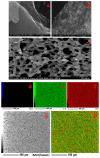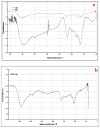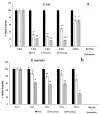Fabrication and Characterization of an Electrospun PHA/Graphene Silver Nanocomposite Scaffold for Antibacterial Applications
- PMID: 30201852
- PMCID: PMC6163631
- DOI: 10.3390/ma11091673
Fabrication and Characterization of an Electrospun PHA/Graphene Silver Nanocomposite Scaffold for Antibacterial Applications
Abstract
Many wounds are unresponsive to currently available treatment techniques and therefore there is an immense need to explore suitable materials, including biomaterials, which could be considered as the crucial factor to accelerate the healing cascade. In this study, we fabricated polyhydroxyalkanoate-based antibacterial mats via an electrospinning technique. One-pot green synthesized graphene-decorated silver nanoparticles (GAg) were incorporated into the fibres of poly-3 hydroxybutarate-co-12 mol.% hydroxyhexanoate (P3HB-co-12 mol.% HHx), a co-polymer of the polyhydroxyalkanoate (PHA) family which is highly biocompatible, biodegradable, and flexible in nature. The synthesized PHA/GAg biomaterial has been characterized by field emission scanning electron microscopy (FESEM), elemental mapping, thermogravimetric analysis (TGA), UV-visible spectroscopy (UV-vis), and Fourier transform infrared spectroscopy (FTIR). An in vitro antibacterial analysis was performed to investigate the efficacy of PHA/GAg against gram-positive Staphylococcus aureus (S. aureus) strain 12,600 ATCC and gram-negative Escherichia coli (E. coli) strain 8739 ATCC. The results indicated that the PHA/GAg demonstrated significant reduction of S. aureus and E. coli as compared to bare PHA or PHA- reduced graphene oxide (rGO) in 2 h of time. The p value (p < 0.05) was obtained by using a two-sample t-test distribution.
Keywords: PHA; antibacterial; electrospun biomaterial; graphene; silver nanoparticles.
Conflict of interest statement
The authors declare no conflict of interest.
Figures










Similar articles
-
Development of Biocompatible Polyhydroxyalkanoate/Chitosan-Tungsten Disulphide Nanocomposite for Antibacterial and Biological Applications.Polymers (Basel). 2022 May 30;14(11):2224. doi: 10.3390/polym14112224. Polymers (Basel). 2022. PMID: 35683897 Free PMC article.
-
Boron Nitride Doped Polyhydroxyalkanoate/Chitosan Nanocomposite for Antibacterial and Biological Applications.Nanomaterials (Basel). 2019 Apr 21;9(4):645. doi: 10.3390/nano9040645. Nanomaterials (Basel). 2019. PMID: 31010071 Free PMC article.
-
Preparation, characterization, and antibacterial activity of silver nanoparticle-decorated graphene oxide nanocomposite.ACS Appl Mater Interfaces. 2015 Apr 1;7(12):6966-73. doi: 10.1021/acsami.5b00937. Epub 2015 Mar 18. ACS Appl Mater Interfaces. 2015. PMID: 25762191
-
Facile synthesis of graphene oxide-silver nanocomposite for decontamination of water from multiple pollutants by adsorption, catalysis and antibacterial activity.J Environ Manage. 2019 Jan 15;230:199-211. doi: 10.1016/j.jenvman.2018.09.061. Epub 2018 Oct 1. J Environ Manage. 2019. PMID: 30286349
-
Combined effect of cellulose nanocrystal and reduced graphene oxide into poly-lactic acid matrix nanocomposite as a scaffold and its anti-bacterial activity.Int J Biol Macromol. 2017 Feb;95:94-105. doi: 10.1016/j.ijbiomac.2016.11.041. Epub 2016 Nov 14. Int J Biol Macromol. 2017. PMID: 27856322
Cited by
-
Facile Synthesis of Silver Nanoparticles with High Antibacterial Activity.Materials (Basel). 2018 Dec 8;11(12):2498. doi: 10.3390/ma11122498. Materials (Basel). 2018. PMID: 30544809 Free PMC article.
-
Innovative Therapeutic and Delivery Approaches Using Nanotechnology to Correct Splicing Defects Underlying Disease.Front Genet. 2020 Jul 14;11:731. doi: 10.3389/fgene.2020.00731. eCollection 2020. Front Genet. 2020. PMID: 32760425 Free PMC article. Review.
-
Development of Biocompatible Polyhydroxyalkanoate/Chitosan-Tungsten Disulphide Nanocomposite for Antibacterial and Biological Applications.Polymers (Basel). 2022 May 30;14(11):2224. doi: 10.3390/polym14112224. Polymers (Basel). 2022. PMID: 35683897 Free PMC article.
-
Zinc oxide nanoparticles conjugated with clinically-approved medicines as potential antibacterial molecules.AMB Express. 2021 Jul 10;11(1):104. doi: 10.1186/s13568-021-01261-1. AMB Express. 2021. PMID: 34245385 Free PMC article.
-
Moxifloxacin and Sulfamethoxazole-Based Nanocarriers Exhibit Potent Antibacterial Activities.Antibiotics (Basel). 2021 Aug 11;10(8):964. doi: 10.3390/antibiotics10080964. Antibiotics (Basel). 2021. PMID: 34439014 Free PMC article.
References
-
- Organization W.H. Antimicrobial Resistance: Global Report on Surveillance. World Health Organization; Geneva, Switzerland: 2014.
Grants and funding
LinkOut - more resources
Full Text Sources
Other Literature Sources

